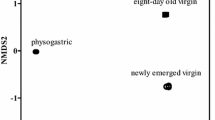Abstract
Chemical compounds on the cuticle are a rich source of information used during interactions among social insects. Despite the multitude of studies on these substances and their function in ants, wasps, and honeybees, little is known about this subject in stingless bees (Hymenoptera: Apidae, Meliponini). We studied the chemical composition of the cuticle of the stingless bee, Frieseomelitta varia, by gas chromatography-mass spectrometry (GC-MS), to investigate potential chemical variation among castes, gender, age, and reproductive status. We found differences in the cuticular hydrocarbon composition among workers, males, and queens, recording both qualitative and quantitative differences among individuals of different ages and gender. The cuticle of physogastric queens presented a chemical profile that was distinct from all other groups in the analysis, with high relative abundances of alkenes and alkadienes with 27, 29, and 31 carbon atoms. We discuss the possibility that these compounds signal a queen’s presence to the colony, thereby initiating all vital worker-queen interactions.



Similar content being viewed by others
References
Abdalla, F. C., Jones, G. R., Morgan, E. D., and Cruz-Landim, C. da. 2003. Comparative study of the cuticular hydrocarbon composition of Melipona bicolor Lepeletier, 1836 (Hymenoptera, Meliponini) workers and queens. Gen. Molec. Res. 2:191–199.
Aitchison, J. 1986. The Statistical Analysis of Compositional Data. Chapman & Hall, London.
Allison, J. D., Borden, J. H., and Seybold, S. J. 2004. A review of the chemical ecology of the Cerambycidae (Coleoptera). Chemoecology 14:123–150.
Boleli, I. C., Simões, Z. L. P., and Bitondi, M. M. G. 1999. Cell death in ovarioles causes permanent sterility in Frieseomelitta varia worker bees. J. Morphol. 242:271–282.
Breed, M. D., Garry, M. F., Pearce, A. N., Hibbard, B. E., Bjostad, L. B., and Page, R. E. Jr. 1995. The role of wax comb in honey bee nestmate recognition. Anim. Behav. 50:489–496.
Breed, M. D., Perry, S., and Bjostad, L. B. 2004. Testing the blank slate hypothesis: why honey bee colonies accept young bees. Insectes Sociaux 51:12–16.
Buchwald, R. and Breed, M. D. 2005. Nestmate recognition cues in stingless bee, Trigona fulviventris. Anim. Behav. 70:1331–1337.
Carlson, D. A., Roan, C. S., Yost, R. A., and Hector, J. 1989. Dimethyl disulfide derivatives of long chain alkenes, alkadienes, and alkatrienes for gas chromatography/mass spectrometry. Anal. Chem. 61:1564–1571.
Downs, S. G. and Ratnieks, F. L. W. 1999. Recognition of conspecifics by honeybee guards uses nonheritable cues acquired in the adult stage. Anim. Behav. 58:643–648.
Endler, A., Liebig, J., Schmitt, T., Parker, J. E., Jones, G. R., Schreier, P., and Hölldobler, B. 2004. Surface hydrocarbons of queen eggs regulate worker reproduction in a social insect. Proc Nat. Acad. Sci USA 101:2945–2950.
Herzner, G., Schmitt, T., Heckel, F., Schreier, P., and Strohm E. 2006. Brothers smell similar: variation in the sex pheromone of male European beewolves, Philanthus triangulum F. (Hymenoptera: Crabronidae), and its implications for inbreeding avoidance. Biol. J. Linn. Soc. 89:433–442.
Howard, R. W. and Blomquist, G. J. 2005. Ecological, behavioral, and biochemical aspects of insect hydrocarbons. Ann. Rev. Entomol. 50:371–393.
Imperatriz-Fonseca, V. L. and Zucchi, R. 1995. Virgin queens in stingless bee (Apidae, Meliponinae) colonies: A review. Apidologie 26:231–244.
Jungnickel, H., Da Costa, A. J. S., Tentschert, J., Patricio, E. F. L. R. A., Imperatriz-Fonseca, V. L., Drijfhout, F., and Morgan, E. D. 2004. Chemical basis for inter-colonial aggression in the stingless bee Scaptotrigona bipunctata (Hymenoptera: Apidae). J. Insect Physiol. 50:761–766.
Keller, L. and Nonacs, P. 1993. The role of queen pheromones in social insects: queen control or queen signal? Anim. Behav. 45:787–794.
Lockey, K. H. 1988. Lipids of the insect cuticle: origin, composition and function. Comp. Biochem. Physiol. 89B:595–645.
Michener, C. D. 2000. The Bees of the World. The Johns Hopkins University Press, Baltimore, MD.
Monnin, T., Malosse, C., and Peeters, C. 1998. Solid-phase microextraction and cuticular hydrocarbon differences related to reproductive activity in queenless ant, Dinoponera quadriceps. J. Chem. Ecol. 24:473–490.
Nunes, T. M., Nascimento, F. S., Turatti, I. C., Lopes, N. P., and Zucchi, R. 2008. Nestmate recognition in a stingless bee: does the similarity of chemical cues determine guard acceptance? Anim. Behav. 75:1165–1171.
Nunes, T. M., Turatti, I. C., Mateus, S., Nascimento, F. S., Lopes, N. P., and Zucchi, R. 2009. Cuticular hydrocarbons in the stingless bee Schwarziana quadripunctata (Hymenoptera, Apidae, Meliponini): differences between colonies, castes and age. Gen. Mol. Res. 8:589–595.
Peeters, C., Monnin, T., and Malosse, C. 1999. Cuticular hydrocarbons correlated with reproductive status in a queenless ant. Proc. Royal Soc. Lond. B 266:1323–1327.
Pianaro, A., Flach, A., Patricio, E. F. L. R. A., Nogueira-Neto, P., and Marsaioli, A. J. 2007. Chemical changes associated with the invasion of a Melipona scutellaris colony by Melipona rufiventris workers. J. Chem. Ecol. 33:971–984.
Sakagami, S. F. 1982. Stingless bees, pp. 361–423, in H. R. Hermann (ed.). Social Insects, Academic, New York.
Acknowledgments
We thank Michael Hrncir for his review of the manuscript. We also thank FAPESP for financial support provided to TMN (Proc. 05/58510-8) and RZ (04/09479-8, Programa Equipamentos Multi-usuários 2).
Author information
Authors and Affiliations
Corresponding author
Rights and permissions
About this article
Cite this article
Nunes, T.M., Turatti, I.C.C., Lopes, N.P. et al. Chemical Signals in the Stingless Bee, Frieseomelitta varia, Indicate Caste, Gender, Age, and Reproductive Status. J Chem Ecol 35, 1172–1180 (2009). https://doi.org/10.1007/s10886-009-9691-8
Received:
Revised:
Accepted:
Published:
Issue Date:
DOI: https://doi.org/10.1007/s10886-009-9691-8




